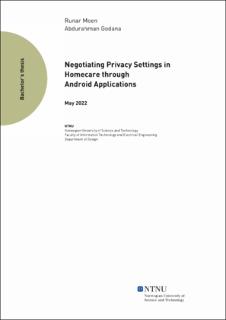Negotiating Privacy Settings in Homecare through Android Applications
| dc.contributor.advisor | Li, Guoqiang | |
| dc.contributor.author | Moen, Runar | |
| dc.contributor.author | Godana, Abdurahman | |
| dc.date.accessioned | 2022-07-07T17:19:42Z | |
| dc.date.available | 2022-07-07T17:19:42Z | |
| dc.date.issued | 2022 | |
| dc.identifier | no.ntnu:inspera:106261571:112575899 | |
| dc.identifier.uri | https://hdl.handle.net/11250/3003598 | |
| dc.description.abstract | Fra 2019 til 2021 har bruken av e-helsetjenester her i Norge økt med 13%. Dette har selvfølgelig fulgt med mange fordeler, men bringer også noen personvernspørsmål for både pasienter og omsorgspersonene som jobber dem. Dette kan være en grunn til bekymring, spesielt i tilfeller der det er konflikt mellom pasientens personvern og kravene som stilles for at omsorgspersonen kan gjøre jobben sin. Hvis en pasient for eksempel sitter i et sykehjem, når skal omsorgspersonen få tilgang til rommet deres? Er det kanskje en måte å håndtere dette elektronisk uten å påføre noen av partene stress? Og hvilken informasjon bør motparten ha tilgang til når det skal det er spørsmål om å opprettholde personvernet deres. Dette var problemstillingen vi ønsket å diskutere i oppgaven vår. I løpet av prosjekt perioden har vi utviklet et konseptbevis på en programvareagent som lar både pasienter og omsorgspersoner kontrollere og synkronisere personverninnstillingene sine på en enkel og sikker måte. Programvaren består av en Android klient og en tilhørende server som vi distribuerte på NTNU sitt OpenStack-nettverk. Gjennom hele prosjektet brukte vi Design Science forskningsmetodikken med et fokus på å utvide og forbedre applikasjonen i fremtiden. Vi gjennomførte også et studie om personvern i sykehjem for å få innsikt i hvordan vi skulle gjennomføre utviklingsprosessen. Dette studiet inkluderer en spørreundersøkelse fordelt på tre ulike brukerroller: pasienter, omsorgspersoner og pasientens familiemedlemmer. Resultatene av dette studiet ble brukt som grunnlag for å bestemme hvilke personverninnstillinger som skulle implementeres i programvaren vår. I denne oppgaven har vi diskutert både de tekniske (relatert til utviklingen av applikasjonen) og forskningsrelaterte (relatert til spørreundersøkelsen) aspektene av prosjektet vårt og gir innsikt i hva vi mener kan være en god løsning på spørsmålene ovenfor. Vi vil også diskutere det manglende ved prosjektet vårt og de aspektene som vi mener kan forbedres hvis vi skulle ta programvaren fra et konseptbevis til et ferdig produkt. | |
| dc.description.abstract | From 2019 to 2021, the use of e-health services here in Norway has increased by 13%. This has of course brought many benefits, but also raises some privacy issues for both patients and the caregivers who care for them. This could be a concern, especially in scenarios where there are conflicts between patient privacy and the demands on caregivers to do their jobs. For example, if a patient is placed in a nursing home, when should the caregiver have access to their room? Is there perhaps a way to handle this electronically without causing either party a lot of stress? And what information should be disclosed to the other party when it comes to maintaining privacy between patient and caregiver? These were the main concerns we wanted to address in our thesis. During the project, we developed a proof-of-concept software agent that allows both patients and caregivers to manage and synchronize their privacy settings simply and securely. The software consists of an Android application running on the client-side and an associated server that we deployed on the NTNU OpenStack network. Throughout the project, we applied the Design Science research methodology with a focus on extending and improving the application in the future. We conducted a study regarding privacy in-home care to gain insight into the development process. First, to support the study, a questionnaire was developed and distributed to three different user roles: patients, caregivers, and patient's family members. The results of the survey conducted served as the basis for determining the privacy settings to be implemented in the software. In this paper, we discuss both the technical aspects (related to the development of the software) and the research aspects (related to the implementation of the survey) of our project and provide some insight into what we think might be a good solution to the questions posed above. We also discuss the shortcomings of our project and the aspects that we believe could be improved if we were to evolve the application from a proof-of-concept to a finished product. | |
| dc.language | eng | |
| dc.publisher | NTNU | |
| dc.title | Negotiating Privacy Settings in Homecare through Android Applications | |
| dc.type | Bachelor thesis |
